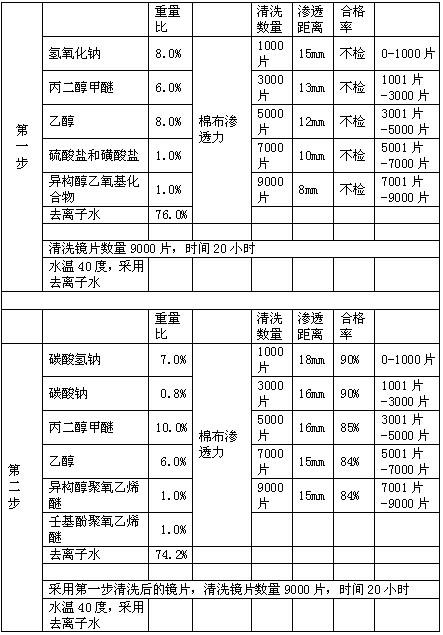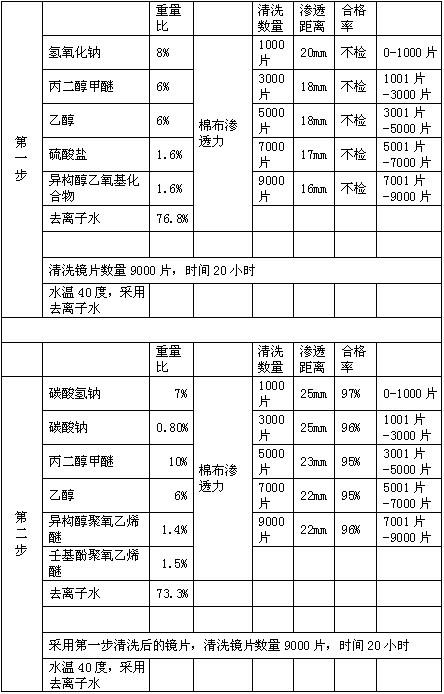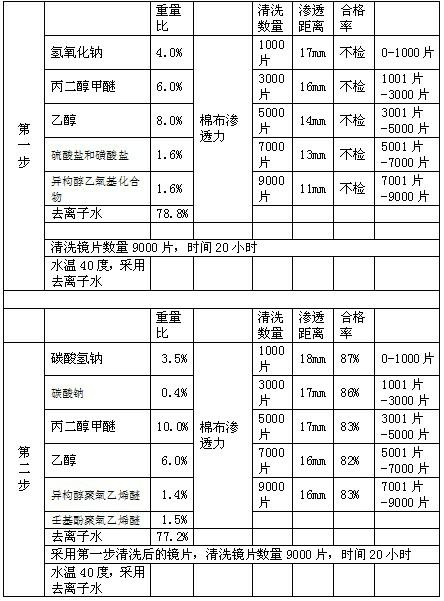Method for cleaning optical lens
A technology for optical lenses and washing liquids, which is applied to chemical instruments and methods, cleaning methods using liquids, cleaning methods, and utensils. Light surface requirements and other issues, to achieve the effect of low foam, high cleaning power
- Summary
- Abstract
- Description
- Claims
- Application Information
AI Technical Summary
Problems solved by technology
Method used
Image
Examples
Embodiment 1
[0013] Test lens parameters: lens diameter 70mm, lens luminosity 0-600 degree random, quantity: 9000 pieces, lens refractive index: 1.56.
[0014] Table I:
[0015]
[0016] From Table 1, the lotion method of the present embodiment, in terms of concentration percentage, comprises the following steps;
[0017] 1. Configure strong alkali and strong alkali-resistant surfactant: take 8% sodium hydroxide, 6% propylene glycol methyl ether, 6% ethanol, 1.6% sulfate, and 1.6% isomeric alcohol ethoxylate , 76.8%% deionized water is mixed evenly and then set aside;
[0018] 2. Configure a weak base and a surfactant that can work in a weak base: take 7% sodium bicarbonate, 0.8% sodium carbonate, 10% propylene glycol methyl ether, 10% ethanol, and 1.4% isomeric alcohol polyoxygen Vinyl ether, 1.5% nonylphenol polyoxyethylene ether and 69.3% deionized water are mixed uniformly and set aside;
[0019] 3. The lens cleaning process is as follows:
[0020] The first step: a) Soak the te...
Embodiment 2
[0029]
[0030] This solution mainly adjusts the surfactant. After the surfactant is adjusted, the penetration of the cotton cloth decreases significantly, and the qualified rate of the lens also decreases, which is generally between 84% and 90%.
Embodiment 3
[0032]
[0033] This plan mainly adjusts the ratio of strong alkali and weak alkali. After the adjustment, the penetration power decreases less, but the main cleaning power decreases, and the pass rate is between 82% and 87%.
PUM
 Login to View More
Login to View More Abstract
Description
Claims
Application Information
 Login to View More
Login to View More - R&D
- Intellectual Property
- Life Sciences
- Materials
- Tech Scout
- Unparalleled Data Quality
- Higher Quality Content
- 60% Fewer Hallucinations
Browse by: Latest US Patents, China's latest patents, Technical Efficacy Thesaurus, Application Domain, Technology Topic, Popular Technical Reports.
© 2025 PatSnap. All rights reserved.Legal|Privacy policy|Modern Slavery Act Transparency Statement|Sitemap|About US| Contact US: help@patsnap.com



